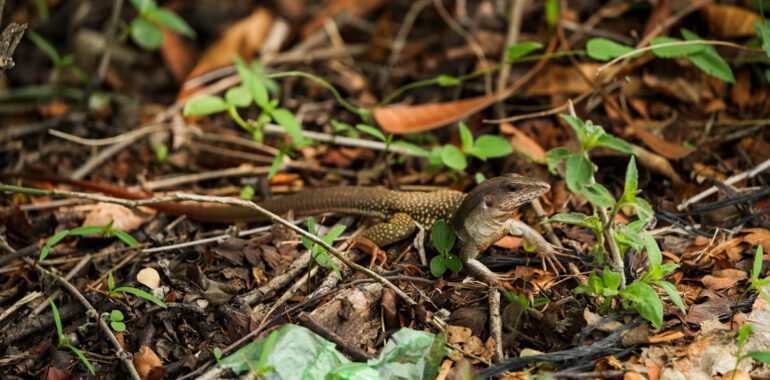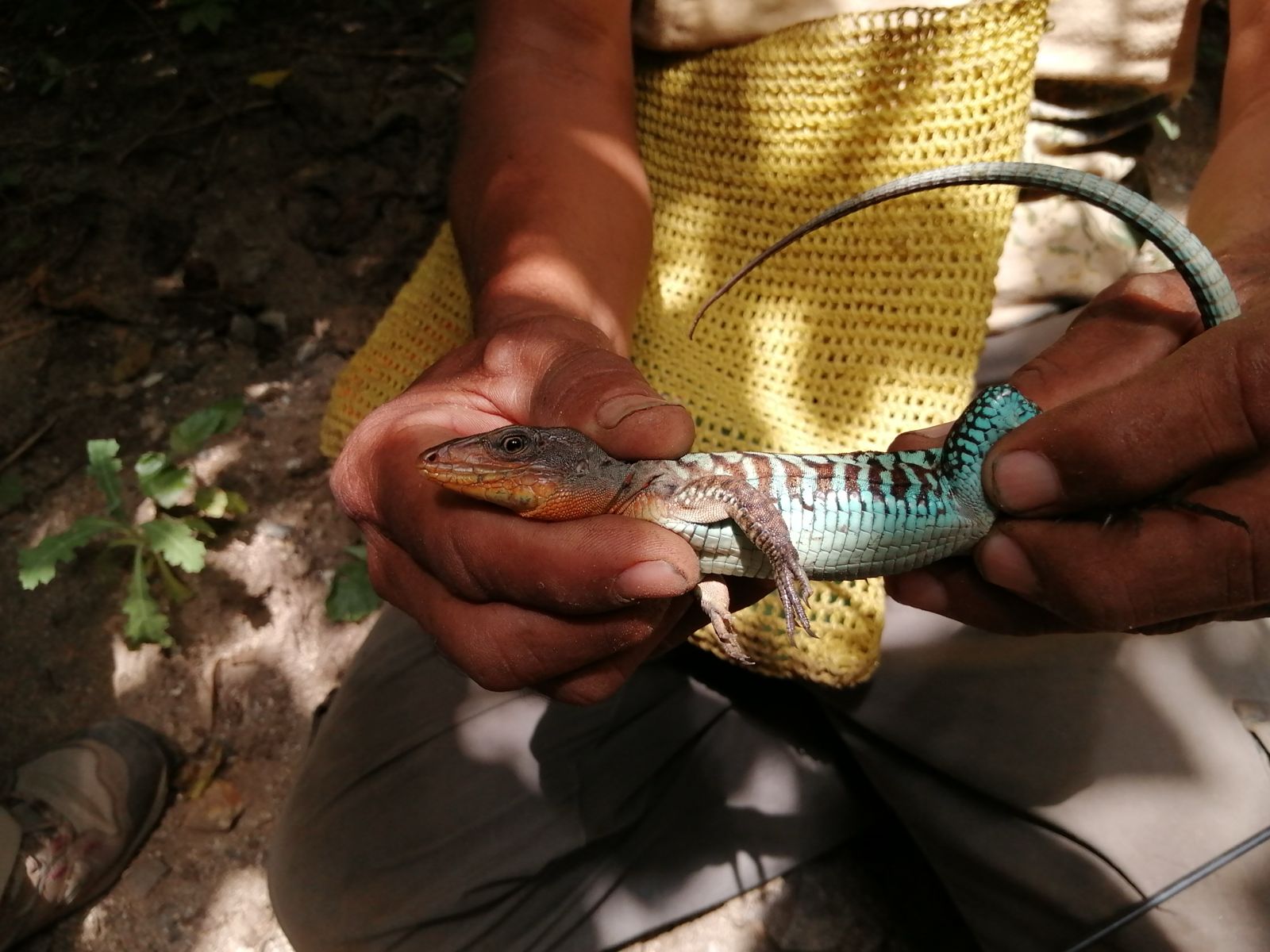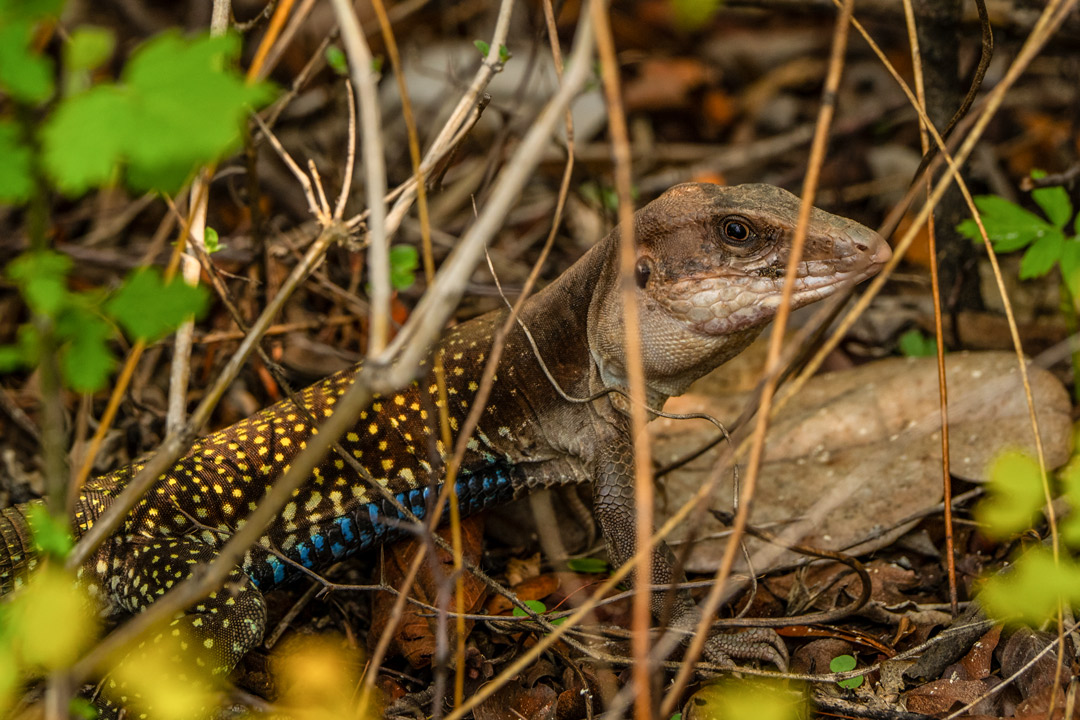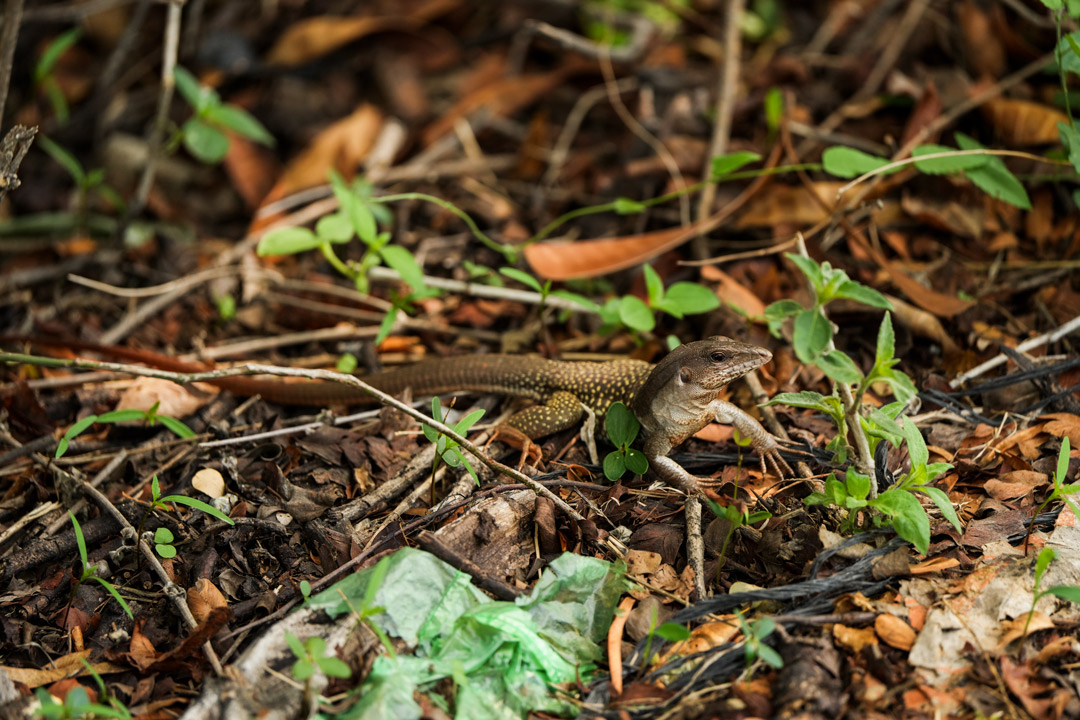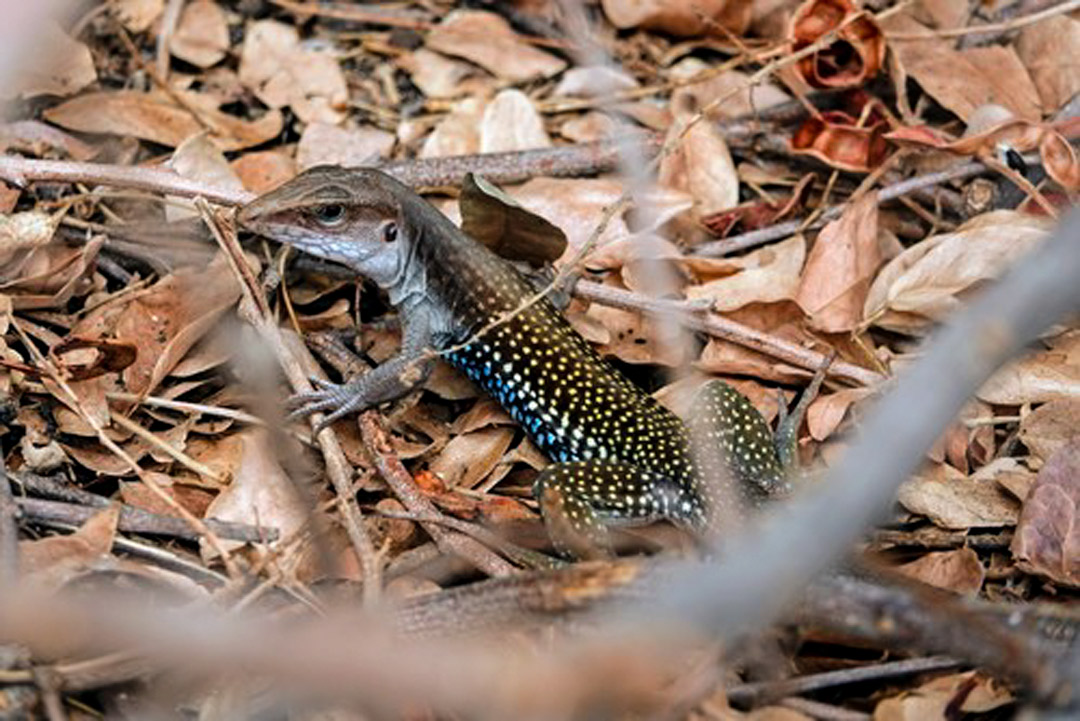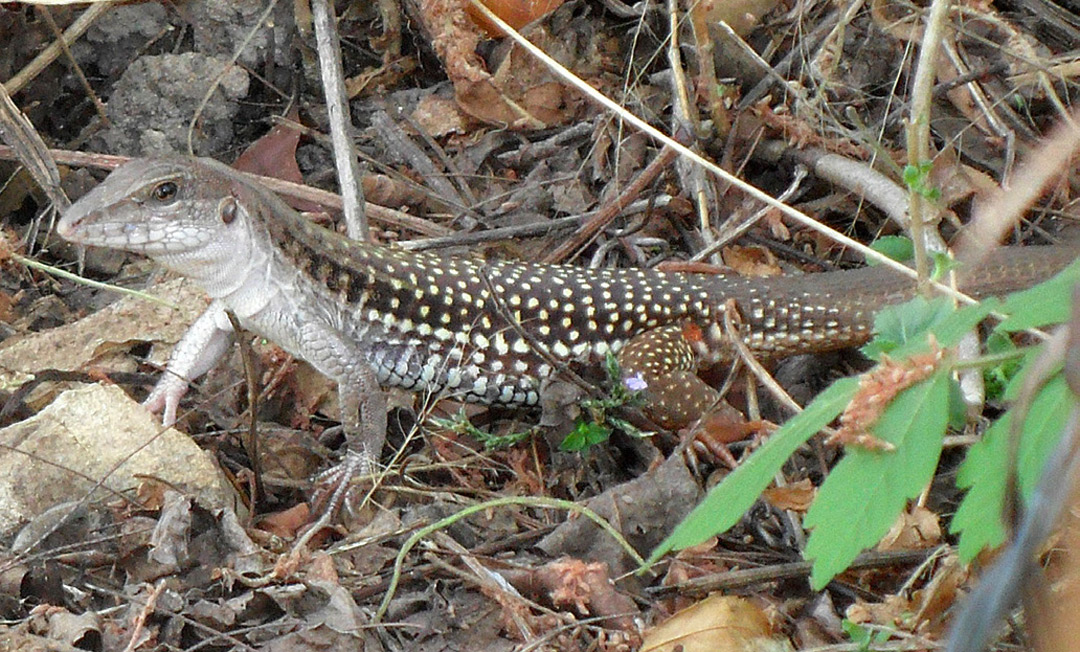Who are the Teiids (Teiidae)?
The genus Aspidoscelis belongs to the family Teiidae. This group includes approximately 110 species reported in regions across the United States, the Mesoamerican zone, South America, and parts of the Antilles (Köhler, 2003). Some of the main genera in this family located in the Mesoamerican region are Aspidoscelis, Cnemidophorus and Holcosus. Teiids are characterized by being medium-sized lizards with strong, well-developed limbs, and a triangular head with large scales known as “shields.” They also possess granular, elongated, and plate-like scales that are important for their identification. Their tails are long and whip-like, and some may exhibit spots or/and stripes with vibrant colors such as blue, green, or even yellow across their brownish bodies. All of these characteristics vary and are expressed differently or similarly depending on the species within this group
Holcosus undulatus, a member of the Teiidae family, being measured for conservation work in La Reserva del Heloderma, Zacapa, Guatemala. Photograph by Biologist Mariana Rivas Gálvez.
What´s up with the genus Aspidoscelis?
Aspidoscelis is one of the most common genera in the dry forest regions of the Mesoamerican zone, including Guatemala. They can be found in areas from North America (excluding Canada), Mexico, and certain locations in Guatemala (Köhler, 2003). One of the emblematic species in the Guatemalan region is Aspidoscelis motaguae, also known as “Huico gigante”, “lagarto cola de látigo” and in Guatemala “polvorín” .This medium-sized (SVL > 100 mm) lizard is found in various regions, from Oaxaca, Mexico, through eastern Guatemala and northwestern El Salvador, to Honduras, in Central America, at altitudes ranging from 500 to 1,200 meters above sea level. This lizard is endemic to this mesoamerican region. In Guatemala, it is found in the dry forests of the Motagua Valley (hence its name “motaguae”).
Aspidoscelis motaguae lizard. Photography by Edwin Solares- El Progreso- Guatemala- May, 2023
A One-of-a-Kind Lizard with a Striking Appearance!
Aspidoscelis motaguae has a distinctive appearance compared to other known lizards, as it resembles a “miniature monitor lizard” when observed alongside other members of the Teiidae family (although these two reptiles are not from the same family; this is merely an analogy). This is due to some aspects of its appearance that make it similar, such as the shape of its head, the arrangement of its limbs, and the size of its tail. Aspidoscelis motaguae features a large, triangular head covered with large, shield-like scales, which are crucial for identifying species within the genus or family. It is known that males are bigger and show more spots with vibrant colors compared to females.
Aspidoscelis motaguae lizard. Photography by Edwin Solares- El Progreso- Guatemala- May, 2023
In Aspidoscelis motaguae, you can clearly observe four supraocular scales along with two plate-like parietal scales (see diagram proposed by Köhler, 2003). Its unique appearance doesn’t stop there, as it possesses well-developed limbs with fine claws that help it move among leaf litter and logs more effectively. Additionally, it has a long, whip-like tail that tapers off toward the tip. Its neck is robust and continues this robust appearance through its back, which is also sturdy and thick. However, the most striking feature of this lizard is its vivid colors on its back and tail, expressed in the form of spots and patches ranging from yellow to blue and green in adults, while juveniles tend to have uniformly brown coloration across their bodies.
(A) Diagrams for the identification of the Aspidoscelis and Cnemidophorus genera reported in Köhler, 2003. The diagrams clearly show the arrangement of scales in A. motaguae.
(B) Comparative photo where the arrangement of head scales is visualized in contrast with diagram (A) for A. motaguae. Photograph by Shlüter, U for the Reptile Database. Access link: https://reptile-database.reptarium.cz/species?genus=Aspidoscelis&species=motaguae.
How do they live? A bit of its ecology!
As other members of the genus, Aspidoscelis motaguae are primarily diurnal reptiles, being most active during the morning when temperatures are warmer. These lizards prefer sunny, warm days, making them more likely to be seen on days with these characteristics. When it’s cloudy or cold, they rarely come out and tend to stay in their caves and/or burrows to avoid the cold temperatures. These lizards mainly feed on insects and arthropods and are active hunters. However, just as they serve as hunters for certain groups of animals, they are also preyed upon by others such as birds, snakes, and/or mammals, making them an important part of the dry forest food chain. These lizards are oviparous, meaning they lay eggs for reproduction. It has been observed that the genus can produce 2-6 clutches per year with 1-5 eggs each, which are buried in the sand for incubation (Köhler, 2003). Aspidoscelis motaguae has terrestrial habits and can be found among leaf litter, on dry logs, around rocks, or any surface with warm characteristics, as mentioned earlier, they prefer environments with ample heat and sunlight.
Aspidoscelis motaguae lizard. Photography by Edwin Solares- El Progreso- Guatemala- May, 2023
Why conserve this species?
It is essential to preserve the lizard Aspidoscelis motaguae due to its critical role in maintaining the stability and functionality of the dry forest ecosystem in Guatemala, as well as its exclusive endemism in the Mesoamerican region. As a unique species in this zone, it presents particular vulnerability to environmental alterations and habitat degradation. Additionally, it plays key ecological roles as a natural regulator of arthropod populations, helping to maintain trophic balance and biotic diversity, as well as serving as prey for other trophic levels. The conservation of A. motaguae is fundamental for safeguarding the genetic richness and biodiversity of the region, which in turn enhances the ecological resilience of Guatemalan dry forests. The loss of this endemic species could trigger significant changes in the structure and functioning of its ecosystem, highlighting the importance of implementing evidence-based conservation strategies for its protection.
Photograph of the Aspidoscelis motaguae lizard reported for the “Portal de Biodiversidad de Guatemala” by Adam Winter. Access link: https://biodiversidad.gt/portal/taxa/index.php?tid=3174
We need to know them better!!
Despite the importance of this lizard within the dry forests of Guatemala and other regions of Mesoamerica, and its well-documented distribution in this area, it is a reptile that requires further research efforts regarding its biology, ecology, populations, and genetics. Gaining a better understanding of these species opens up the opportunity to conserve them more effectively and clarifies their ecological roles within their ecosystem, which directly influences the proper conservation of their habitat and its components. Do you know any researchers who might be interested in learning more about the species? Don’t hesitate to share this news with them so they can learn about the research opportunity available with this incredible reptile!
The Aspidoscelis motaguae lizard photograph from the scientific article “First record of Aspidoscelis motaguae (Sackett, 1941) (Reptilia: Squamata: Teiidae) from Nicaragua” as a contribution to the research on this fascinating species (Kohler, et.al., 2013). Access link: https://www.biotaxa.org/cl/article/view/9.2.475
Reference, read more about them in Kohler.
- 2003
- Reptiles of Central America. Offenbach: Herpeton Verlag, 2003 ISBN 3-936180-02-4

